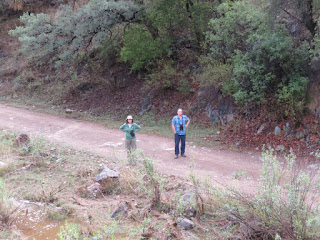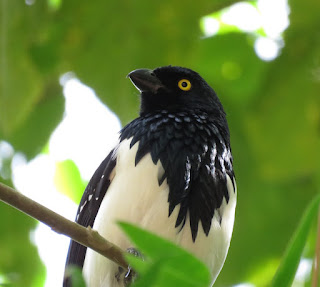This past
July I agreed to lead conservationist Sharon Forsyth on a five-day private
birding tour in Arizona – five days sandwiched between my tours to Brazil and
Costa Rica with only two days’ cushion on either side. Sharon had birded here
only once or twice before; I had met her on a day-long field trip I led here
for the American Bird Conservancy board, on which Sharon sits, a year and a
half ago (I blogged a bit about it here).
This was her second attempt to find a gap in my schedule to do a tour in
Arizona, and we’re both very glad it worked out.
Sharon
cajoled her husband Adrian to join her for three of the five days, and it was a
real treat for me to sneak in some natural history observations with such a
well-known tropical ecologist. He’s also a pretty good birder.
We started
in Florida Canyon where we easily caught up with one of the breeding
Rufous-capped Warblers. Adrian was more fascinated with all the net-winged beetles
and other insects on this Dasylirion
wheeleri, Sotol flower spike. It seems there’s virtually nothing known
about the pollination ecology of this plant. It’s said to be wind-pollinated,
but the numbers of insects on this spike suggest it might be more complicated
than that.
It’s early
in the monsoon, but things are starting to get green and insects are already
abundant. This robber fly Diogmites
sallei, Salle's Hanging Thief, was one of the more common insects flushed
at our feet.
I imitated
owls to bring in this Northern Beardless-Tyrannulet very close.
We then
visited Montosa Canyon on the west side of the Santa Ritas. In the large
culvert there I found this Ascalapha
odorata, Black Witch. This moth does not breed in Arizona but is found here
only as a stray dispersing from Mexico.
The next
morning we visited California Gulch. We had intended on trying for
Buff-collared Nightjar, but we left later than I had planned, and debris on the
road from last night’s monsoon storms slowed us down, and we arrived too late.
But timing was perfect for Five-striped Sparrow, a main target.
I was
surprised to see this Passiflora
arizonica, Arizona Passionflower already in full bloom, since the rains had
only started a few days earlier. It was getting a head start, predicting some
more rain no doubt.
After losing
three hours getting a tire replaced and another patched at the Walmart in
Nogales, we continued to the Sycamore Canyon east of there in the Patagonia Mountains.
First we stopped on the road for this crossing Aphonopelma chalcodes, Desert Blond Tarantula.
Turning over
some debris I found this Vaejovis
spinigerus, Stripe-tailed Scorpion.
This area
had received a bit more rain, and fungi were up everywhere. This puffball is an
Astraeus sp.
This huge
and gorgeous flower is Ipomoea longifolia,
Pinkthroat Morning-glory.
Our main
birding target here was the resident pair of Spotted Owls, and we found a pair
of them.
We then
spent a couple nights at the delightful Casa de San Pedro, finding this Terrapene ornata, Ornate Box Turtle on
the entrance road nearby.
From our
base in Hereford, we visited several canyons in the Huachuca Mountains. Our
main target at the Reef Townsite campground was this Tufted Flycatcher, one of
two pair now breeding in these mountains, an unprecedented range expansion that
began two years ago.
When Adrian
left us for meetings back East, Sharon and I hiked into upper Ramsey Canyon,
where we were successful finding the single male Flame-colored Tanager.
Sharon and I
then spent our last night at Portal where Mexican Chickadee was our primary
target, which we relatively easily found. But there were so many other
interesting critters there. In one drainage were several damselflies, Argia plana, Springwater Dancer.
This tachinid
fly is easily recognized as Adejeania
vexatrix.
A classic
shot of the handsome Pterourus
multicaudata, Two-tailed Swallowtail.
We had been
remarking about the utter lack of snakes on our trip so far when I spotted this
Salvadora grahamiae, Eastern
Patch-nosed Snake, stretched out across the road on our way back to Tucson.
I then had just
two days back at home before I departed for Costa Rica.













































